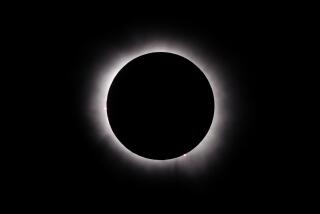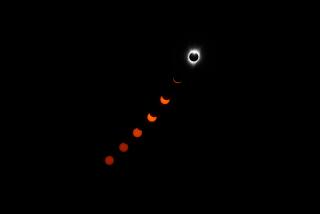Look Into the Sun and You May Be Dazzled
- Share via
People were lined up for at least a half a mile--staring, transfixed. Kids on bikes stopped in their tracks, leaning with elbows on handlebars. An old lady in her walker turned to look. Fathers lifted toddlers on their shoulders. The roller-bladers braked. Dogs sat silent on leashes, waiting for signs of life from suddenly still masters. Homeless people wrapped in blankets came to look. Even the runners paused, putting aerobics on hold.
At first, I thought something horrible had happened. But, no. It was only (only?) a sunset at Santa Monica beach. In a singular act of community, L.A. sun worshipers lived up to their name, bidding Old Sol adieu with fitting reverence. Or at least, bonne nuit.
What is it about a sunset? Surely, it’s not just the color. You can get almost the same thing from a good box of paints.
Or even, if you like to play, by shining a flashlight through water sprinkled through with powdered milk. The milk, it turns out, makes particles of just the right size to scatter the blue light preferentially out the side, leaving only the red to travel the distance. It’s exactly what air does to sunlight. So if you shine the yellow flashlight through the long end of a glass loaf pan, the sides will look sky blue, but down at the end, you’ll see a shimmering red-orange ball.
*
It’s not that hard to cook up a sunset in a pan.
OK, so maybe a loaf pan full of colored light isn’t the same as a whole sky aglow. But still, I think there’s more to the way the sun moves us than mere (mere?) beauty.
At some level, I think even people who know nothing about physics understand just how remarkable a thing it is, this yellow star of ours. Turning matter into energy as surely as Rumpelstiltskin turned straw into gold. Except that the sun’s gold is really manna from heaven, the stuff we eat for breakfast, lunch and dinner.
(The energy you use to read this sentence is powered, ultimately, by sunlight--perhaps first soaked up by some grass that got digested by a cow before it turned into the milk that made the cheese that topped the pizza. But sunlight, just the same.)
It’s a godlike power, for sure. Perhaps that’s why people were so upset when Galileo published a letter in 1613 suggesting that the sun was less than perfect; that it broke out sporadically with imperfections, like ordinary folk. The dark blotches Galileo saw suggested that the sun was up to something--not just some lazy orb, as the ancients had thought, with nothing to do but roll around heaven all day.
Now, we know the dark spots are relatively cool areas where the sun’s magnetic fields get knotted up, twisted around by the star’s rapidly spinning, electrically charged atmosphere. It’s a mystery, still, how those spots come and go, and the more astronomers learn, the more interesting the mystery seems to get.
The spots, which are associated with intense magnetic activity, come and go in 11-year cycles. As the last cycle’s spots disappear near the sun’s equator, new ones pop up at the poles--but with the magnetic poles reversed. No one can figure out how a star manages to turn itself inside out at such regular intervals, or why.
Or figure this: The entire sun pulses in regular five-minute intervals. (No wonder it’s the whole planet’s heartthrob.) In addition, it rings in dozens of different harmonics, which are now being studied by the equivalent of Earth-based stethoscopes placed strategically round the globe.
There’s only so much you can learn from a distance, however, so NASA has sent up a spacecraft to bask in the sun’s glow for a couple of years, collecting the star’s hot breath on silicon detectors. In 2004, the craft is due to swoop down over Utah, where the samples will be collected by helicopter.
The mission, aptly named Genesis, is after no less than the story of our own origins.
Some 4.5 billion years ago, the sun, planets and moons all condensed out of the same maternal gas cloud; when the planets spun off, the sun held on to more than 95% of that primordial stuff. It still does.
Humanity really is a chip off that old block. If we can bottle the stuff and bring it home to our laboratories, we’ll find out a lot more about ourselves.
As the days get longer, I realize how much I’ve missed the sun during its long hibernation. How much I appreciate all it does for us: putting tails on comets; driving weather; making pizza.
Finally, here comes the sun. Goodness, gracious, great balls of fire.
More to Read
Sign up for The Wild
We’ll help you find the best places to hike, bike and run, as well as the perfect silent spots for meditation and yoga.
You may occasionally receive promotional content from the Los Angeles Times.






